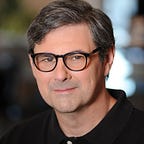HoloLens 2: When magic matures
Welcome to XR Frontiers, a series of articles exploring the intersection of extended reality and business reality.
The biggest mystery around the original HoloLens was not how Microsoft had developed the device itself under such a shroud of secrecy, but how it had apparently built the time machine in order to pluck the thing from the future. As the Oculus Rift marked a milestone in creating a convincing virtual reality experience, so did the HoloLens for augmented reality.
This week, Microsoft showed off the second generation of the device. Powered by the Qualcomm Snapdragon 850 Mobile Compute Platform and leveraging display technology developed in-house, the HoloLens 2 boasts a wider field of view, hand tracking, and better ergonomics. A launch event in downtown Manhattan provided an opportunity to have a fresh look at the capabilities of the device and its surrounding ecosystem that offered a glimpse in how far extended reality has come and where it is going.
One demonstration was of Spatial, the AR meeting and the collaboration app. In many respects. Spatial is a forward-looking application because it is one of the relatively few horizontal applications to leverage the HoloLens. While those may have a longer ROI timeline than vertical apps, I was not surprised when CEO Anand Agarawala shared some of the large companies that have been using Spatial with me since it is an ideal application for companies that want to experiment with holographic work without necessarily going through the custom development that might be required of a more focused pilot.
The Spatial team captured a bit of footage of me using their product. (Note the smile, a nearly involuntary biological response nearly everyone who tries new HoloLens experiences encounters.)
For me, though, Spatial also offers a look into how the rapid progress we are seeing in extended reality. I first wrote about the app a year ago with the first-generation HoloLens. Compared to that initial implementation, Spatial now offers more realistic avatars (although I’d still like to see more facial expression variety) and more natural object manipulation courtesy the hand tracking of the HoloLens 2.
But the most immediate impact of the upgrade comes from the new devices vastly expanded field of view. With the first version, an utterance might yield a frantic scanning of the room to find the avatar speaking. With the HoloLens 2, though, a quick turn of the head is all that is needed to find the speaker. This, of course, holds true for other resources in the room as well.
Another demo showed off the value of Microsoft’s spatial computing ecosystem, even if the HoloLens itself did not play a role. Minecraft Earth brings the decade-old megahit building game that Microsoft acquired in 2014 into the real world, Pokemon Go-style. However, compared to other augmented reality games, the experience is far richer in part due to Azure Spatial Anchors, cloud technology for pinpointing objects in the physical world within a few centimeters. Using the technology, I was able to use an iPad to engage with other players in an extended reality mini-quest as the shared structure central to the adventure was approached consistently from multiple perspectives as a real-world object would be.
Today, the HoloLens 2 is out of reach for such trivial pursuits, but a future version that might bring the price down to consumer price points would make the experience even more fun. For now, the technology’s cross-platform support is facilitating usage in enterprise applications where a HoloLens cannot yet be justified for all participants. As iOS and Android native client support helps build momentum, though, Microsoft is encouraging enterprises to build applications that can drive business value today while encouraging the adoption of hands-free options tomorrow.
Ross Rubin is principal analyst at Reticle Research and a contributor to ZDNet and Fast Company. He is also co-host of the Techspansive podcast. You can follow him on Twitter at @rossrubin.
